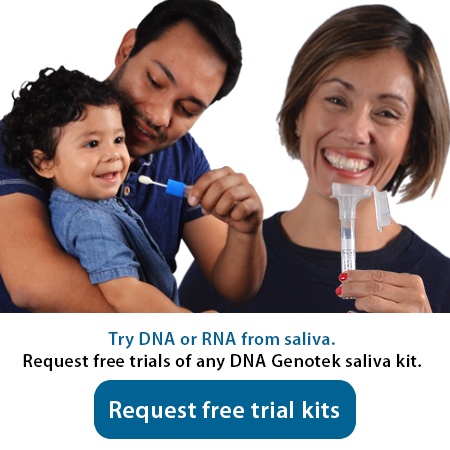2010-07-07
A host of familial cancer syndromes have been described in which several members of the same family develop cancer at a young age due to an inherited genetic susceptibility. It has been well established that germline mutations in the DNA sequence of genes that are protective against cancer, including tumour suppressor and DNA repair genes, are the culprit in most familial cases of cancer. Because they are inherited, these germline mutations are present in every cell of the body from conception into adulthood, knocking out one of the two copies of the protective gene. They confer a high risk of cancer development at a young age, although the cancer itself arises when the remaining normally-functioning copy of the gene is knocked out in susceptible tissues due to contributing environmental conditions, taking with it the last remnants of protection it once afforded against cancer. However, for a number of individuals with young-onset cancer, as well as entire families, the inherited defect remains unidentified, which complicates genetic counselling and clinical management of family members. Lynch syndrome is the most common of all family cancer syndromes, in which patients develop a range of cancers, the most frequent of which are colorectal and uterine cancers. Lynch syndrome is usually caused by germline mutations within one of the four genes that encode the mismatch repair system, most commonly MLH1 or MSH2. Loss of protection from the mismatch repair system results in the accumulation of mutations during cell division, and ultimately, cancer ensues. However, in about a third of Lynch syndrome patients, standard genetic screening fails to identify any pathogenic sequence change within the mismatch repair genes that might be responsible for their disease.
The focus of the Medical Epigenetics Laboratory at the Lowy Cancer Research Centre in Sydney, Australia, led by Megan Hitchins PhD, is to determine the role of a new type of defect, termed a "constitutional epimutation" in predisposing to young-onset cancer syndromes. The first case of a "constitutional epimutation" was reported for the MLH1 gene in a patient with Lynch syndrome in 2002.1 This represents a new epigenetic mechanism of cancer susceptibility, in which the gene's promoter (the equivalent of its engine) is clogged with the chemical methylation, causing the affected copy to be switched off, even though its DNA code is entirely normal. Thus, "epimutation" refers to the nature of the defect, which occurs over and above the context of DNA sequence, whilst "constitutional" denotes the intrinsic presence of this epigenetic defect in normal tissues. Cancer similarly develops after the active copy of the gene is lost in the vulnerable tissues, giving rise to the same clinical profile as carriers of conventional sequence mutations of MLH1. However, one of the key differences between a constitutional epimutation and a sequence mutation is that the gene methylation can be unstable and sometimes show a "mosaic" pattern, that is, it may be present in a patchwork of some cell or tissue-types, whilst absent in others. The level of methylation in the body may even vary during the course of the carrier's life-time. This facet of epimutations adds to the challenge of identifying those who carry them, since their identifying factor - the presence of methylation - may not necessarily be detectable in DNA extracted from a single source, typically peripheral blood. A further complicating factor is that unlike germline mutations that demonstrate classic Mendelian patterns of inheritance, transmission of epimutations from one generation to the next is unpredictable.
This non-Mendelian inheritance is attributable to the fact that methylation is stripped away during the reproductive life-cycle, and so epimutations tend to be reversed between generations and may, or may not, be re-imposed after fertilization in the developing fetus. Indeed, it is likely that the degree of methylation mosaicism witnessed in carriers reflects the stage of embryogenesis during which the methylation was established in them. Therefore, when it comes to screening for epimutations, for instance in the family members of a cancer patient found to carry one, it is prudent to test the DNA extracted from more than one tissue-type. Otherwise, it begs the question of whether a negative test means those relatives are safe from cancer as non-carriers, or whether it is just didn't show up in the tissue tested due to the mosaic nature of methylation.
To minimize the possibility of failing to detect an epimutation, we have adopted the approach of testing DNA extracted from different tissue sources, namely blood, hair bulbs, buccal swabs, and thanks to the Oragene kits, saliva. In fact, since saliva is originally derived from the same embryonic cell lineage as the colon, it may even provide a more accurate representation of the epigenetic changes that have occurred in the colon than blood.
In our recent article in the International Journal of Cancer,2 we show for the first time that in one case, Patient YT, who developed colon cancer at the age of just 18 years due to a constitutional MLH1 epimutation, that methylation was present in his saliva, as per other normal cells (Figure 1a). Thus his saliva showed a consistent pattern with other sources of tissue, indicating a severe soma-wide epimutation (Figure b). Furthermore, using the saliva RNA extraction kit, we were also able to show that the methylated copy of the gene was completely switched off (Figure 1c). Interestingly, screening of his parents showed that neither of them had any detectable methylation, despite screening multiple tissues including their saliva, and so we could say with confidence that the epimutation had arisen spontaneously in their cancer-affected son, but that they themselves were not at an elevated risk of developing cancer from the same type of defect.
 Figure 1. Constitutional MLH1 epimutation in "Patient YT"
Figure 1. Constitutional MLH1 epimutation in "Patient YT"
A: Schematic overview comparing a constitutional epimutation of MLH1, as found in Patient YT, with the normal gene of a healthy individual. Rectangles denote the two copies of the gene and its mRNA product. Methylation of the promoter is depicted by black lollipops. Gene activity is denoted by a waved arrow. The common c.655A>G SNP within the protein-code portion of the MLH1 gene is shown, which enables the two copies of the gene to be distinguished from one another, allowing the activity of the two alleles to be traced in the mRNA. B: Allelic patterns of MLH1 methylation showed methylation was widespread in normal somatic tissues, including saliva collected using the Oragene kit. The "beads of string" represent individual strands of DNA from the MLH1 promoter with dots showing positions of methylation present (black) or absent (white) at CG sites within the DNA sequence, at which methylation is capable of binding. C: Quantification by pyrosequencing of the two copies of the MLH1 gene in the genomic DNA and mRNA samples derived from saliva collected using the Oragene kits. The yellow-shaded region shows the peaks representing each allele at the SNP site. Two peaks showing equal levels of the ‘A' and ‘G' alleles in his saliva DNA show the patient is heterozygous for the benign c.655A>G SNP, allowing the two copies of to be differentiated. However, in his saliva mRNA, only the ‘G' allele was detected, indicating that the ‘A' allele has been switched off by the promoter methylation further upstream.
Our laboratory now routinely collects saliva using the Oragene kits from patients with colon cancer who we suspect may have been caused by intrinsic epigenetic changes, since we believe methylation may be elevated and hence more easily detected in this source of DNA than in blood. Furthermore, we are finding that our rate of compliance in providing samples for diagnostic or research purposes has increased. Firstly, those who are elderly, sick or have an aversion to needles are more willing to provide a sample of saliva than blood for DNA or RNA extraction. Secondly, in our research endeavouring to unravel the inheritance pattern of constitutional MLH1 epimutations, we rely on the voluntary contribution of specimens from the asymptomatic relatives of cancer patients who carry this defect. Relatives are happier to provide a specimen of saliva at their own convenience and in the comfort of their own home, than in visiting their clinician or pathology laboratory to provide a blood sample. Following contact by phone with the genetic counsellor or research nurse, they simply place their saliva sample in the stamped addressed envelope we provide and return it to the laboratory by post, along with their signed consent form approving the inclusion of their sample in our research study.
To this end, the Oragene saliva kits have greatly facilitated our research from a logistical perspective, whilst also providing a new dimension for testing different tissue-types for epigenetic changes that may vary from one tissue source to another.
References
1. Gazzoli, I., Loda, M., Garber, J., Syngal, S. & Kolodner, R.D. A hereditary nonpolyposis colorectal carcinoma case associated with hypermethylation of the MLH1 gene in normal tissue and loss of heterozygosity of the unmethylated allele in the resulting microsatellite instability-high tumor. Cancer Res 62, 3925-8 (2002).2. Goel A, Nguyen T-P, Hon-Chiu E Leung H-CE, Nagasaka T, Rhees J, Hotchkiss E, Arnold M, Banerji P, Koi M, Kwok C-T, Packham D, Lipton L, Boland CR, Ward RL, Hitchins MP. De novo constitutional MLH1 epimutations confer early-onset colorectal cancer in two new sporadic Lynch syndrome cases, with derivation of the epimutation on the paternal allele in one. International Journal of Cancer 2010, in press.


